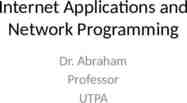L20: Processes Processes CSE CSE 351 351 Autumn Autumn 2017 2017
47 Slides3.41 MB

L20: Processes Processes CSE CSE 351 351 Autumn Autumn 2017 2017 Instructor: Justin Hsia Teaching Assistants: Lucas Wotton Michael Zhang Parker DeWilde Ryan Wong Sam Gehman Sam WolfsonSavanna Yee Vinny Palaniappan http://xkcd.com/292/ CSE351, Autumn 2017

L20: Processes CSE351, Autumn 2017 Administrivia Homework 4 due Friday (11/17) Lab 4 due after Thanksgiving (11/27) Parts of this lab are new, so don’t hesitate to ask if anything is unclear or seem buggy! 2

L20: Processes CSE351, Autumn 2017 Processes Processes and context switching Creating new processes fork(), exec*(), and wait() Zombies 3

L20: Processes CSE351, Autumn 2017 What is a process? It’s an illusion! Process 1 Memory Stack Heap Data Code CPU Registers %rip Disk Chrome.exe 4

L20: Processes CSE351, Autumn 2017 What is a process? Another abstraction in our computer system Provided by the OS OS uses a data structure to represent each process Maintains the interface between the program and the underlying hardware (CPU memory) What do processes have to do with exceptional control flow? Exceptional control flow is the mechanism the OS uses to enable multiple processes to run on the same system What is the difference between: A processor? A program? A process? 5

L20: Processes CSE351, Autumn 2017 Processes A process is an instance of a running program One of the most profound ideas in computer science Not the same as “program” or “processor” Process provides each program with two key abstractions: Logical control flow Each program seems to have exclusive use of the CPU Provided by kernel mechanism called context switching Private address space Each program seems to have exclusive use of main memory Provided by kernel mechanism called virtual memory Memory Stack Heap Data Code CPU Registers 6

L20: Processes What is a process? CSE351, Autumn 2017 It’s an illusion! Computer Process 3 “Memory” Process 2 Stack Heap Data Code “Memory” Stack Heap Data Code Process 1 “Memory” “CPU” Registers “Memory” Registers Stack Heap Data Code Stack Heap Data Code “CPU” Process 4 “CPU” “CPU” Registers Registers CPU Disk /Applications/ Chrome.exe Slack.exe PowerPoint.exe 7

L20: Processes What is a process? CSE351, Autumn 2017 It’s an illusion! Computer Process 3 “Memory” Process 2 Stack Heap Data Code “Memory” Stack Heap Data Code Process 1 “Memory” “CPU” Registers “Memory” Registers Stack Heap Data Code Stack Heap Data Code “CPU” Process 4 “CPU” “CPU” Registers Registers Operating System CPU Disk /Applications/ Chrome.exe Slack.exe PowerPoint.exe 8

L20: Processes CSE351, Autumn 2017 Multiprocessing: The Illusion Memory Memory Memory Stack Heap Data Code Stack Heap Data Code Stack Heap Data Code CPU CPU CPU Registers Registers Registers Computer runs many processes simultaneously Applications for one or more users Web browsers, email clients, editors, Background tasks Monitoring network & I/O devices 9

L20: Processes CSE351, Autumn 2017 Multiprocessing: The Reality Memory Stack Stack Stack Heap Data Code Heap Data Code Heap Data Code Saved registers Saved registers Saved registers CPU Registers Single processor executes multiple processes concurrently Process executions interleaved, CPU runs one at a time Address spaces managed by virtual memory system (later in course) Execution context (register values, stack, ) for other processes saved in memory 10

L20: Processes CSE351, Autumn 2017 Multiprocessing Memory Stack Stack Stack Heap Data Code Heap Data Code Heap Data Code Saved registers Saved registers Saved registers CPU Registers Context switch 1) Save current registers in memory 11

L20: Processes CSE351, Autumn 2017 Multiprocessing Memory Stack Stack Stack Heap Data Code Heap Data Code Heap Data Code Saved registers Saved registers Saved registers CPU Registers Context switch 1) Save current registers in memory 2) Schedule next process for execution 12

L20: Processes CSE351, Autumn 2017 Multiprocessing Memory Stack Stack Stack Heap Data Code Heap Data Code Heap Data Code Saved registers Saved registers Saved registers CPU Registers Context switch 1) Save current registers in memory 2) Schedule next process for execution 3) Load saved registers and switch address space 13

L20: Processes CSE351, Autumn 2017 Multiprocessing: The (Modern) Reality Memory Stack Stack Stack Heap Data Code Heap Data Code Heap Data Code Saved registers Saved registers CPU CPU Registers Registers Saved registers Multicore processors Multiple CPUs (“cores”) on single chip Share main memory (and some of the caches) Each can execute a separate process Kernel schedules processes to cores Still constantly swapping processes 14

L20: Processes Assume only one CPU Concurrent Processes CSE351, Autumn 2017 Each process is a logical control flow Two processes run concurrently (are concurrent) if their instruction executions (flows) overlap in time Otherwise, they are sequential Example: (running on single core) Concurrent: A & B, A & C Sequential: B & C Process A Process B Process C time 15

L20: Processes User’s View of Concurrency CSE351, Autumn 2017 Assume only one CPU Control flows for concurrent processes are physically disjoint in time CPU only executes instructions for one process at a time However, the user can think of concurrent processes as executing at the same time, in parallel Process A Process B Process C Process A Process B Process C tim e User View 16

L20: Processes Context Switching CSE351, Autumn 2017 Assume only one CPU Processes are managed by a shared chunk of OS code called the kernel The kernel is not a separate process, but rather runs as part of a user process In x86-64 Linux: Same address in each process refers to same shared memory location 17

L20: Processes CSE351, Autumn 2017 Assume only one CPU Context Switching Processes are managed by a shared chunk of OS code called the kernel The kernel is not a separate process, but rather runs as part of a user process Context switch passes control flow from one process to another and is performed using kernel code Process A Process B Excep tio time user code n kernel code context switch user code kernel code context switch user code 18

L20: Processes CSE351, Autumn 2017 Processes Processes and context switching Creating new processes fork() , exec*(), and wait() Zombies 19

L20: Processes CSE351, Autumn 2017 Creating New Processes & Programs Process 1 Process 2 “Memory” “Memory” Stack Heap Data Code Stack Heap Data Code fork() “CPU” “CPU” Registers Registers exec*() Chrome.exe 20

L20: Processes CSE351, Autumn 2017 Creating New Processes & Programs fork-exec model (Linux): fork() creates a copy of the current process exec*() replaces the current process’ code and address space with the code for a different program Family: execv, execl, execve, execle, execvp, execlp fork() and execve() are system calls Other system calls for process management: getpid() exit() wait(), waitpid() 21

L20: Processes CSE351, Autumn 2017 fork: Creating New Processes pid t fork(void) Creates a new “child” process that is identical to the calling “parent” process, including all state (memory, registers, etc.) Returns 0 to the child process Returns child’s process ID (PID) to the parent process Child is almost identical to parent: Child gets an identical (but separate) copy of the parent’s virtual address space Child has a different PID than the parent pid t pid fork(); if (pid 0) { printf("hello from child\n"); } else { printf("hello from parent\n"); } fork is unique (and often confusing) because it is called once but returns “twice” 22

L20: Processes CSE351, Autumn 2017 Understanding fork Process X (parent) pid t pid fork(); if (pid 0) { printf("hello from child\n"); } else { printf("hello from parent\n"); } Process Y (child) pid t pid fork(); if (pid 0) { printf("hello from child\n"); } else { printf("hello from parent\n"); } 23

L20: Processes CSE351, Autumn 2017 Understanding fork Process X (parent) Process Y (child) pid t pid fork(); if (pid 0) { printf("hello from child\n"); } else { printf("hello from parent\n"); } pid t pid fork(); if (pid 0) { printf("hello from child\n"); } else { printf("hello from parent\n"); } pid t pid fork(); pid Y if (pid 0) { printf("hello from child\n"); } else { printf("hello from parent\n"); } pid t pid fork(); pid 0 if (pid 0) { printf("hello from child\n"); } else { printf("hello from parent\n"); } 24

L20: Processes CSE351, Autumn 2017 Understanding fork Process X (parent) Process Y (child) pid t pid fork(); if (pid 0) { printf("hello from child\n"); } else { printf("hello from parent\n"); } pid t pid fork(); if (pid 0) { printf("hello from child\n"); } else { printf("hello from parent\n"); } pid t pid fork(); pid Y if (pid 0) { printf("hello from child\n"); } else { printf("hello from parent\n"); } pid t pid fork(); pid 0 if (pid 0) { printf("hello from child\n"); } else { printf("hello from parent\n"); } hello from parent hello from child Which one appears first? 25

L20: Processes CSE351, Autumn 2017 Fork Example void fork1() { int x 1; pid t pid fork(); if (pid 0) printf("Child has x %d\n", x); else printf("Parent has x %d\n", --x); printf("Bye from process %d with x %d\n", getpid(), x); } Both processes continue/start execution after fork Child starts at instruction after the call to fork (storing into pid) Can’t predict execution order of parent and child Both processes start with x 1 Subsequent changes to x are independent Shared open files: stdout is the same in both parent and child 26

L20: Processes CSE351, Autumn 2017 Modeling fork with Process Graphs A process graph is a useful tool for capturing the partial ordering of statements in a concurrent program Each vertex is the execution of a statement a b means a happens before b Edges can be labeled with current value of variables printf vertices can be labeled with output Each graph begins with a vertex with no inedges Any topological sort of the graph corresponds to a feasible total ordering Total ordering of vertices where all edges point from left to right 27

L20: Processes CSE351, Autumn 2017 Fork Example: Possible Output void fork1() { int x 1; pid t pid fork(); if (pid 0) printf("Child has x %d\n", x); else printf("Parent has x %d\n", --x); printf("Bye from process %d with x %d\n", getpid(), x); } x 1 fork x 2 x Child printf Bye printf x 0 --x Parent printf Bye printf 28

L20: Processes CSE351, Autumn 2017 Peer Instruction Question Are the following sequences of outputs possible? Vote at http://PollEv.com/justinh void nestedfork() { printf("L0\n"); if (fork() 0) { printf("L1\n"); if (fork() 0) { printf("L2\n"); } } printf("Bye\n"); } Seq 1: L0 L1 Bye Bye Bye L2 A. B. C. D. E. Seq 2: L0 Bye L1 L2 Bye Bye No No No Yes Yes No Yes Yes We’re lost 29

L20: Processes Fork-Exec CSE351, Autumn 2017 Note: the return values of fork and exec* should be checked for errors fork-exec model: fork() creates a copy of the current process exec*() replaces the current process’ code and address space with the code for a different program Whole family of exec calls – see exec(3) and execve(2) // Example arguments: path "/usr/bin/ls", // argv[0] "/usr/bin/ls", argv[1] "-ahl", argv[2] NULL void fork exec(char *path, char *argv[]) { pid t pid fork(); if (pid ! 0) { printf("Parent: created a child %d\n", pid); } else { printf("Child: about to exec a new program\n"); execv(path, argv); } printf("This line printed by parent only!\n"); } 30

L20: Processes CSE351, Autumn 2017 Exec-ing a new program Stack Very high-level diagram of what happens when you run the command “ls” in a Linux shell: Heap Data Code: /usr/bin/bash parent fork() Stack This is the loading part of CALL! child child Stack Stack exec*() Heap Heap Data Code: /usr/bin/bash Data Code: /usr/bin/bash Data Code: /usr/bin/ls 31

L20: Processes CSE351, Autumn 2017 This is extra (non-testable) material Execute “/usr/bin/ls –l lab4” in child process using current environment: execve Example (argc 3) myargv environ myargv[argc] NULL myargv[2] myargv[1] myargv[0] envp[n] NULL envp[n-1] . envp[0] “lab4” “-l” “/usr/bin/ls” “PWD /homes/iws/jhsia” “USER jhsia” if ((pid fork()) 0) { /* Child runs program */ if (execve(myargv[0], myargv, environ) 0) { printf("%s: Command not found.\n", myargv[0]); exit(1); } } Run the printenv command in a Linux shell to see your own environment variables 32

L20: Processes Structure of the Stack when a new program starts This is extra (non-testable) material CSE351, Autumn 2017 Null-terminated environment variable strings Bottom of stack Null-terminated command-line arg strings envp[n] NULL envp[n-1] . environ (global var) envp[0] argv[argc] NULL argv[argc-1] envp (in %rdx) . argv (in %rsi) argv[0] argc (in %rdi) Stack frame for libc start main Top of stack Future stack frame for main 33

L20: Processes CSE351, Autumn 2017 exit: Ending a process void exit(int status) Exits a process Status code: 0 is used for a normal exit, nonzero for abnormal exit 34

L20: Processes CSE351, Autumn 2017 Processes Processes and context switching Creating new processes fork(), exec*(), and wait() Zombies 35

L20: Processes CSE351, Autumn 2017 Zombies When a process terminates, it still consumes system resources Various tables maintained by OS Called a “zombie” (a living corpse, half alive and half dead) Reaping is performed by parent on terminated child Parent is given exit status information and kernel then deletes zombie child process What if parent doesn’t reap? If any parent terminates without reaping a child, then the orphaned child will be reaped by init process (pid 1) Note: on more recent Linux systems, init has been renamed systemd In long-running processes (e.g. shells, servers) we need explicit reaping 36

L20: Processes CSE351, Autumn 2017 wait: Synchronizing with Children int wait(int *child status) Suspends current process (i.e. the parent) until one of its children terminates Return value is the PID of the child process that terminated On successful return, the child process is reaped If child status ! NULL, then the *child status value indicates why the child process terminated Special macros for interpreting this status – see man wait(2) Note: If parent process has multiple children, wait will return when any of the children terminates waitpid can be used to wait on a specific child process 37

L20: Processes CSE351, Autumn 2017 wait: Synchronizing with Children void fork wait() { int child status; if (fork() 0) { printf("HC: hello from child\n"); exit(0); } else { printf("HP: hello from parent\n"); wait(&child status); printf("CT: child has terminated\n"); } printf("Bye\n"); forks.c } HC printf HP fork printf exit CT Bye wait printf Feasible output: HC HP CT Bye Infeasible output: HP CT Bye HC 38

L20: Processes Example: Zombie CSE351, Autumn 2017 void fork7() { if (fork() 0) { /* Child */ printf("Terminating Child, PID %d\n", getpid()); exit(0); } else { printf("Running Parent, PID %d\n", getpid()); while (1); /* Infinite loop */ } } forks.c linux ./forks 7 & [1] 6639 Running Parent, PID 6639 Terminating Child, PID 6640 linux ps PID TTY TIME CMD 6585 ttyp9 00:00:00 tcsh 6639 ttyp9 00:00:03 forks 6640 ttyp9 00:00:00 forks defunct 6641 ttyp9 00:00:00 ps linux kill 6639 [1] Terminated linux ps PID TTY TIME CMD 6585 ttyp9 00:00:00 tcsh 6642 ttyp9 00:00:00 ps ps shows child process as “defunct” Killing parent allows child to be reaped by init 39

L20: Processes Example: Non-terminating Child CSE351, Autumn 2017 void fork8() { if (fork() 0) { /* Child */ printf("Running Child, PID %d\n", getpid()); while (1); /* Infinite loop */ } else { printf("Terminating Parent, PID %d\n", getpid()); exit(0); } } forks.c linux ./forks 8 Terminating Parent, PID 6675 Running Child, PID 6676 linux ps PID TTY TIME CMD 6585 ttyp9 00:00:00 tcsh 6676 ttyp9 00:00:06 forks 6677 ttyp9 00:00:00 ps linux kill 6676 linux ps PID TTY TIME CMD 6585 ttyp9 00:00:00 tcsh 6678 ttyp9 00:00:00 ps Child process still active even though parent has terminated Must kill explicitly, or else will keep running indefinitely 40

L20: Processes CSE351, Autumn 2017 Process Management Summary fork makes two copies of the same process (parent & child) Returns different values to the two processes exec* replaces current process from file (new program) Two-process program: First fork() if (pid 0) { /* child code */ } else { /* parent code */ } Two different programs: First fork() if (pid 0) { execv( ) } else { /* parent code */ } wait or waitpid used to synchronize parent/child execution and to reap child process 41

L20: Processes CSE351, Autumn 2017 Summary Processes At any given time, system has multiple active processes On a one-CPU system, only one can execute at a time, but each process appears to have total control of the processor OS periodically “context switches” between active processes Implemented using exceptional control flow Process management fork: one call, two returns execve: one call, usually no return wait or waitpid: synchronization exit: one call, no return 42

L20: Processes CSE351, Autumn 2017 BONUS SLIDES Detailed examples: Consecutive forks wait() example waitpid() example 43

L20: Processes CSE351, Autumn 2017 Example: Two consecutive forks Bye void fork2() { printf("L0\n"); fork(); printf("L1\n"); fork(); printf("Bye\n"); } printf Bye L1 printf fork printf Bye printf L0 printf Bye L1 fork printf Feasible output: L0 L1 Bye Bye L1 Bye Bye fork printf Infeasible output: L0 Bye L1 Bye L1 Bye Bye 44

L20: Processes CSE351, Autumn 2017 Example: Three consecutive forks Both parent and child can continue forking void fork3() { printf("L0\n"); fork(); printf("L1\n"); fork(); printf("L2\n"); fork(); printf("Bye\n"); } Bye L2 Bye Bye L1 L2 Bye Bye L2 Bye Bye L0 L1 L2 Bye 45

L20: Processes CSE351, Autumn 2017 wait() Example If multiple children completed, will take in arbitrary order Can use macros WIFEXITED and WEXITSTATUS to get information about exit status void fork10() { pid t pid[N]; int i; int child status; for (i 0; i N; i ) if ((pid[i] fork()) 0) exit(100 i); /* Child */ for (i 0; i N; i ) { pid t wpid wait(&child status); if (WIFEXITED(child status)) printf("Child %d terminated with exit status %d\n", wpid, WEXITSTATUS(child status)); else printf("Child %d terminated abnormally\n", wpid); } } 46

L20: Processes CSE351, Autumn 2017 waitpid(): Waiting for a Specific Process pid t waitpid(pid t pid,int &status,int options) suspends current process until specific process terminates various options (that we won’t talk about) void fork11() { pid t pid[N]; int i; int child status; for (i 0; i N; i ) if ((pid[i] fork()) 0) exit(100 i); /* Child */ for (i 0; i N; i ) { pid t wpid waitpid(pid[i], &child status, 0); if (WIFEXITED(child status)) printf("Child %d terminated with exit status %d\n", wpid, WEXITSTATUS(child status)); else printf("Child %d terminated abnormally\n", wpid); } } 47






